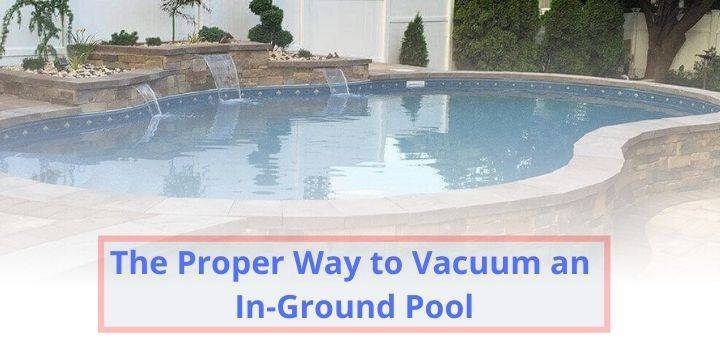How to Vacuum an Inground Pool Would it be wonderful living in a world where pools and not just inground pools just stayed clean? After working so hard into owning an inground pool in your backyard to offer leisure and entertainment, it’s the dream of homeowners’ for an automatic sparkling clean pool at all times. However, that’s not the case.
One standard maintenance procedure for ensuring the inground pool remains clean at least most of the time is through Vacuuming. So how do you vacuum an inground pool?
How to Vacuuming an Inground Pool
Vacuuming the pool depends on the level of dirt in the pool. The multiport filter valve has two settings for filter cleaning or waste cleaning. For higher levels of sediment such as after a storm or after treatment for an increase of algae in the pool, waste cleaning is done. In this case, the multiport filter valve is set to waste or drain setting.
If it’s for routine cleaning the multiport filter valve is set to use a filter valve to remove the sediments, and then pass the filtered water through return lines back into the pool.
What are the items needed to perform a vacuum cleaning of an inground pool for a sparkling and thoroughly clean pool?
PoolEquipments Needed To Vacuum a Pool
Recommended Post: Best Chlorinator for In-ground Pool
Routine vacuuming
For routine vacuuming once a week where there are light to moderate levels of pool dirt, you might consider using an automatic pool cleaner. In automatic cleaning, normal filtration is carried out. For quick results, we have chosen a sand filter. The sand filter will effectively filter off the dirt.

In this situation, the automatic pool cleaner uses circulation pump suction to remove sediment from the pool floor and wall.
During this process, the water is pumped under positive pressure through the vacuum head and the dirt and debris water is passed through the sand filter trapping all the waste and then allowing the filtered water back into the pool through return lines. This filter setting of pool cleaning is done within an hour by a robot pool cleaner or pressure-side pool cleaner.
Concentrated amounts of dirt and other sediments may be deposited in the sand filter after cleaning. Therefore the standard procedure of performing a routine backwash on the filter after vacuuming should be followed.
Thereafter the pool is once again sparkling and you are ready for a cool summer vibe.
Heavy Pool Contamination
Stormy weather might increase the levels of dirt and sediments in the pool and chemical treatments may also lead to a rapid bloom of algae contaminating the pool water.
In this situation, it’s high time you clean the water from the pool by resetting the multiport filter valve to waste vacuuming. This setting works by draining the water from the pool without passing it through a filter.
Simple Steps to Vacuum Clean Your Pool
After getting all items you are now ready to clean the pool. So let’s get started.
Step 1: Removing Suspended Dirt and Debris;
Using a skimmer basket, pull out the leaves, dirt, and debris that are afloat or suspended in the water. For dirt and debris will sink to the bottom of the pool or stick to the sides. These will be removed by the vacuum cleaner.
Step 2: Multiport Settings
Depending on the level of dirt in the pool you will either set the multiport into filter vacuuming if the dirt and debris are low or waste vacuuming if the dirt level is quite high.
Filter Vacuuming
For filter, vacuuming starts by taking the telescoping pole and the vacuum head and snapping them together. Take the skimmer basket off and plug it into one inlet end of the vacuum hose.

Start vacuuming from the shallow end and moving towards the deeper end. Move the vacuum head slowly back and forth over the bottom of the pool in linear passes. You shouldn’t go fast to avoid stirring the dirt in the water.
The vacuum hose directs the pump suction to the vacuum head and the vacuum force generated pumps water under negative pressure.
After the vacuum hose is filled with water, the Vacuumed dirt and debris are then pushed through the skimmer inlet into the pump and then to the sand filter. The dirt and debris are then filtered by the sand filter media and the water renter the pool.
Waste Vacuuming
Where pool water is filled with sediments algae or where dirt or dust has formed a thick layer on the bottom vacuuming to a sand filter is not recommended because the filter will overload with waste and this may occlude the filter media.
The multiport is set therefore to a “waste setting”. This setting bypasses the filter and redirects the contaminated water to an external drain for disposal. Using this setting prevents the filter from clogging with an overload of debris, flocculant, and sediments.
Once the pool water is drained away, clean the pool floor with the pool vacuum. Move the vacuum back and forth across the bottom of the pool. As the skimmer pulls water through the vacuum tool the vacuum head is rolled over the bottom and sides of the pool sucking up dirt and sediment.
After vacuuming is completed the water in the pool is not returned and this will drop its level quickly. Therefore it must be added to restore it to the proper level. In turn, this addition of fresh water necessitates the need to test and correct the chlorine and pH balance in the pool.
Testing the water’s pH level is best done by cakie digital pH meter water quality tester. On testing, the right ph level should be between 7 to 8. Additionally, add sanitizing tablets to release chlorine. The chlorine will kill any bacteria in the water.
Step 3: Using the Scrub Brush
The scrub brush is used when cleaning the pool’s walls, floor, and pool deck. You will need a bucket full of water and a squirt of dish soap. Ensure you don’t use too much. Mix the dish soap. On cleaning the pool deck, Spread the solution to cover the pool deck and use the scrub brush to clean thoroughly. After cleaning satisfactorily rinse the deck with a pressure washer connected to a suction pump.
On cleaning the walls detach the telescopic pole from the vacuum cleaner and attach it to the Pool Brush. Scrub The Pool Walls And Floor Removing Dirt Specks And Algae.
Step 4: Disconnect, Change Filter Setting, and Backwash the Filter
Once done vacuuming the pool to your satisfaction, detach the pool from the vacuum head by pulling the vacuum hose off. Drain water from the vacuum hose and rinse everything using fresh water.
Next Change the filter setting. First, locate the on/off switch and turn it off. It’s located at the pressure gauge. Failure to switch it off could damage the internal filter parts.
Next backwash the filter. Ensure that the pressure gauge reads 10 psi. Slide the hose clamp over the end of the backwash hose and put the end of the hose over the backwash nozzle of the filter system. Turn the multiport valve into a backwash to let the water drain through the backwash nozzle.
Next turn the filter back on and watch as it washes until the water in the cleaner becomes clear. Once the water becomes clear turn the multiport valve to rinse to flush out the remaining dirt from the filter. Let it run for 45 seconds.
Finally switch the filter from the rinse function to the filter function to let the pressure gauge read to normal.
Related Post: Best Pool Vacuum for Dirt
FAQs
How Often Should The Sand Filter Be Changed?
Sand filters usually last on average 6 years. For longer sand filter life use a sand filter cleaner periodically once a year. The sand filter cleaner removes oil that hinders the normal filtering process.
Pool filters and pool filter sand alternatives are the best sand filter products. Sand filters are sold in different diameters ranging from 16 inches to 36 inches. For a properly sized sand filter, the rule of thumb is to buy 1.5 sq ft of filter per 10,000 gallons of water.
What do I do if I’m not getting any pressure when vacuuming my pool?
If you experience low pressure this could be a result of low PSI. The water level in the skimmer needs to increase for it to function. Alternatively, the skimmer basket could be clogged leading to low PSI. Therefore you ought to clear the basket from the debris.
How do I take care of my pool?
Since Pools increase the property value of your home, it’s rather important to always ensure it’s properly catered for. Below are some maintenance schedules you can use.
How do I make my pool crystal clear?
With a few steps transforming your pool into a crystal clear pool is quite possible.
Ensure the chemical levels are optimum. The recommended levels for chlorine, cyan uric acid, pH level, and calcium level are indicated by manufacturers.
Use shock and flocculants weekly to kill growing algae. Following the manufacturer’s instructions when you shock avoid using excessive amounts. An excessive amount might lead to the rapid growth of algae.
Use automatic cleaners when doing routine cleaning. Automatic cleaners will make your cleaning less time-consuming. They are best recommended if the pool is slightly unclean with dirt and sediments.
The best-selling automatic vacuum cleaner for the in-ground pools is Dolphin Nautilus Cc Plus Automatic Robotic Pool Cleaner With Easy To Clean Large Top Load Filter Cartridge For In-Ground Swimming Pool. It’s a pocket-friendly robotic vacuum cleaner that is pocket friendly and does a thorough cleaning of the pool. It is best recommended for large pools or pools with hard-to-reach areas.
Manual cleaning of the pool is recommended when the condition of the pool is too unclean for filter cleaning only. Too much dirt will make the vacuum cleaner malfunction. You might also need professional help if the job gets too much. Its best recommended also to follow environmental procedures whenever draining the pool.
Backwash also your filter every time you clean your pool to ensure the vacuum cleaner continues to clean without leaving dust and particulates behind.
Skim regularly removing suspended leaves, dust, and insects to make the pool tidy.
These easy steps keep your pool from turning cloudy and even green and rather will turn the pool into an amazingly clear and sparkling pool to enjoy.
Conclusion
There is no doubt that it’s important to keep your pool in perfect condition for health reasons and to protect it as an investment because it will improve the value of your home. With these few tips, you are surely going to get a clean and sparkling pool. pool vacuum for sand
- 15 Must-Have Products to Start Your Cozy Outdoor Kitchen - July 15, 2025
- 30 Cozy Outdoor Kitchen Ideas You Can Try in Any Backyard - July 14, 2025
- 27 Cozy Dark Bedroom Inspiration Ideas for Warm and Relaxing - July 13, 2025

